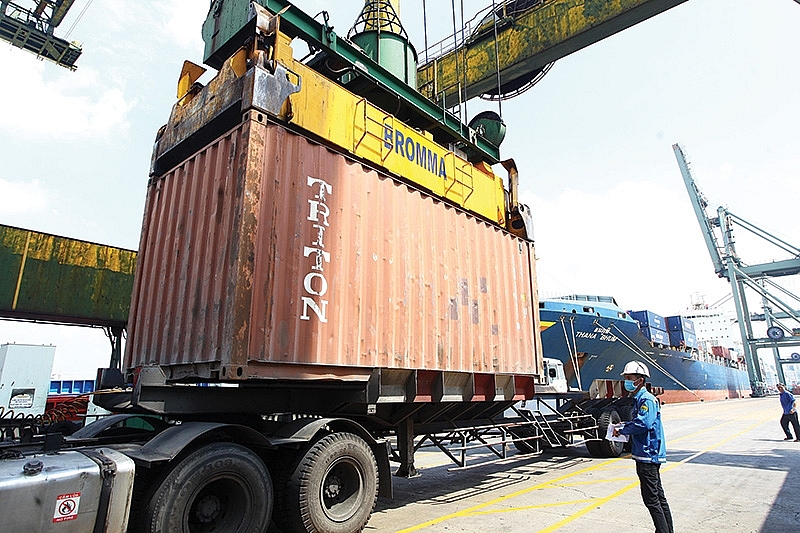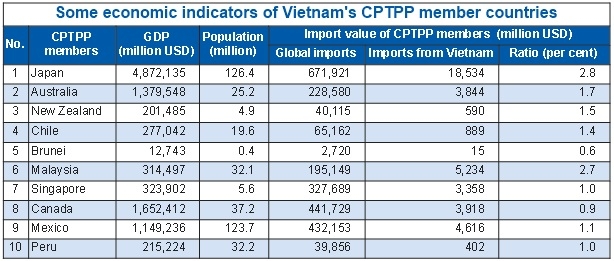Global trade opens to local companies
 |
| With an array of tariffs set to be heavily reduced, Vietnamese companies will have a golden chance to export to some of the world’s biggest markets, Photo: Le Toan |
 |
| Note: 2017 figures - Source: Ministry of Industry and Trade |
| The Ministry of Industry and Trade (MoIT) has just approved a plan for the implementation of the Comprehensive and Progressive Agreement for Trans-Pacific Partnership (CPTPP), to which Vietnam is a signatory. The plan details the main targets and tasks assigned to each agency in the MoIT, along with requirements on their deadlines and outcomes. The main tasks, including the prompt creation of regulatory documents on the implementation of the trade pact, particularly in export and import management, traceability and competitiveness, will be carried out in two phases. The first phase will start this year, while the second will be launched in the 2020-2025 period, with a vision towards 2035. The MoIT has also launched a new website, cptpp.moit.gov.vn, where the business community and local people can learn more about the CPTPP. Detailed explanations for commitments are also provided for readers to better understand the trade deal. The website also includes information for exporters, such as the commitments of member countries and those regarding the opening of service markets and investment for Vietnamese providers in other CPTPP markets. The website boasts the full CPTPP text in both English and Vietnamese, along with relevant documents including the government’s plans for implementing the deal and the legal amendments. |
TNG chairman Nguyen Van Thoi has said that his business, among the top 10 garment and textile companies in the country, will gain significant advantages from the Comprehensive and Progressive Agreement for Trans-Pacific Partnership (CPTPP), thanks to tariff cuts that help Vietnamese-made products compete directly with Chinese goods.
“Thanks to the deal, the number of our company’s export orders to the Canadian market will increase about 6-7 per cent this year, maybe even up to 10 per cent, which could help TNG’s revenue to reach about $10 million annually”, said Thoi.
Many other businesses like TNG have also actively sought export opportunities into the CPTPP member markets, which comprise the third-largest free trade area in the world in GDP, after the North American Free Trade Agreement and the EU’s European Single Market.
Golden gate to export
The CPTPP will open new opportunities for trade and create conditions to restructure both export and import markets. Under a study recently conducted by Vietnam’s Ministry of Planning and Investment (MPI), the CPTPP can expand Vietnam’s GDP and export turnover by 1.32 and 4.04 per cent, respectively, until 2035. Total import turnover will also likely rise by an additional 3.8 per cent until 2035.
Kenneth Atkinson, executive chairman of US-backed consulting firm Grant Thornton Vietnam said, “The opportunities are of course driven by the fact that trade among the member countries will be the agreement to reduce tariffs on goods and services traded between them, and although the size of the market is greatly reduced from that of the original TPP because of the withdrawal of the United States, the market created by the remaining members still accounts for approximately 13.5 per cent of global trade.”
He continued, “The initial beneficiaries are likely to be those companies engaged in manufacturing in Vietnam’s traditional export sectors, such as garments and footwear plus seafood exporters, and those companies and sectors not currently trading with the member countries. Basically, any industry that will benefit from tariff reductions is likely to benefit in the longer term.”
The CPTPP’s member countries have pledged to cut 77-100 per cent of tariff lines on ordinary Vietnamese goods, according to a report from the Ministry of Industry and Trade (MoIT). For example, Canada has committed to reducing 94.9 per cent of its import tariff lines, which accounts for 77.9 per cent of the total value of exports from Vietnam. For products such as furniture and seafood such as frozen shrimp, pangasius, and tuna, Canada’s level of commitment is 100 per cent, which means that seafood and furniture will be duty-free when imported into Canada. Thus, thousands of tariff lines will be abolished for domestic products, opening up many fresh opportunities for domestic exporters, especially those in the footwear sector. Up to 78 per cent of the revenue from Vietnamese footwear exports to Canada will be exempt from taxes.
Meanwhile, Japan will eliminate 86 per cent of tariff lines as soon as the trade pact becomes effective, and almost 90 per cent after five years. This is the first time Japan has exempted most of Vietnam’s agricultural and seafood imports from duties.
The key export sectors to Canada, Chile, and Australia of textiles, footwear, and seafood will also see new opportunities as the CPTPP comes into effect, while Malaysia, Indonesia, Singapore, Mexico, and New Zealand will open up the gates for Vietnamese-exported items such as phones and computers, according to the MoIT.
Furthermore, the MoIT said that the total global import value of the 10 members in the CPTPP amounts to nearly $2.5 trillion. Meanwhile, Vietnam’s existing export turnover from these countries sat at nearly $42 billion last year. Thus, the room for Vietnamese exports to these markets remains large.
Eased rule of origin
Frederick Burke, managing partner of Baker McKenzie in Vietnam, noted that besides tariff cuts, the CPTPP takes a more simplified approach where importers are allowed to complete the origin certification for the goods they import. Accordingly, member importers who meet certain conditions set forth by the regulators in their country may self-certify the origin of the product they are importing, a first for Vietnam.
Traditionally, origin is only certified by the exporter or the manufacturer, after which the certificate of origin must be issued by the competent authority of the exporting country. In a more advanced approach, this certificate may be issued by the exporter or manufacturer, for example through the ASEAN Trade in Goods Agreement.
Besides, it is expected that engaging in the CPTPP will help Vietnam restructure its import-export markets.
Oliver Massmann, general director of Duane Morris Vietnam LLC, said that aside from expanding markets, the CPTPP also helps balance relationships with key markets, approach larger markets including Japan and Canada, reduces any trade deficit, and can attract foreign investment. It will also help the Vietnamese economy allocate resources more effectively, enabling active support to the processes of restructuring, innovation, and regulatory improvement, as well as bolstering administrative reforms.
What the stars mean:
★ Poor ★ ★ Promising ★★★ Good ★★★★ Very good ★★★★★ Exceptional
Themes: CPTPP
Related Contents
Latest News
More News
- Human-centred governance seen as key to AI development (December 19, 2025 | 18:19)
- Top 10 notable events of Vietnam’s industry and trade sector in 2025 (December 19, 2025 | 14:00)
- Tungsten surges to 12-year high as world enters a new 'black gold' race (December 18, 2025 | 17:27)
- Vietnam’s coffee exports set new record despite price pressures (December 18, 2025 | 17:13)
- Garment and textile sector seeks new growth after volatile year (December 18, 2025 | 17:01)
- VinSpeed and Siemens strengthen cooperation for high-speed rail development (December 18, 2025 | 16:53)
- High-tech adoption for TH true MILK (December 18, 2025 | 13:39)
- Takeda supports health resilience amid climate change challenges (December 18, 2025 | 12:39)
- Mondelez Kinh Do - a chapter of purpose-led leadership in Vietnam (December 18, 2025 | 09:44)
- VNPAY services receive the highest-level PCI DSS international security certificates for six consecutive years (December 17, 2025 | 23:47)

 Tag:
Tag:





















 Mobile Version
Mobile Version